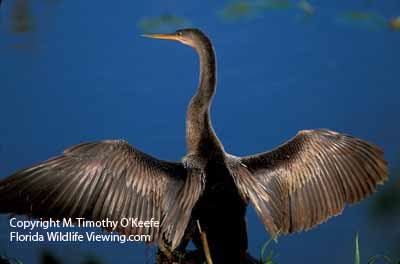 |
|
||||||||||
|
|
Everglades Birding Hotspots
Anhinga, or water turkey, drying its wings. The terrain of the Everglades, mostly a shallow plain of sawgrass that grows in water only about 6 inches deep, is ideal wading bird habitat. This blanket of water, which has been likened to a tropical, primordial soup of algae and bacteria, nourishes snakes, turtles, fish and insects which in turn feed the incredibly rich population of birds.
Royal Palm Hammock is on the left, just 2 miles from the entrance. The half-mile long Anhinga Trail, the park's single most popular trail, is named for one of Florida 's most distinctive birds. The anhinga is also called the water turkey and snake bird, since it swims almost totally submerged with only its snaky-looking long neck and head above water. It captures food by diving underwater and spearing fish with its beak. The anhinga is the bird frequently spotted perched on a branch with its wings spread like it's in a state of alarm. The bird is actually drying its feathers. The anhinga lacks the oil glands needed to keep its plumage dry. If the anhinga didn't drip-dry itself regularly, it would become so water-logged it would sink. Follow the paved trail to a boardwalk that penetrates a sawgrass prairie. Along the way look for sora, smooth-billed ani, least bittern and great white heron. By February the birds should be concentrating around places like Paurotis Pond (named for the paurotis palms) and Nine-Mile Pond. Both are good sites for short-tailed hawks, osprey, herons, bald eagles and what many consider to be the emblematic bird of the Everglades --the roseate spoonbill. If you miss spotting a spoonbill at Paurotis or Nine Mile Pond, look again at Mrazek Pond near Flamingo. Around the ponds, both migratory and the smaller resident cormorants, Caspian terns, mottled ducks and swallow-tailed kites may also be present during the day; look for limpkins and white-crowned pigeons early and late. Waterfowl have always been particularly fond of West Lake : American widgeon, ruddy, pintail, shoveler, scaup (lesser and ring-necked) and teal (green and blue-winged). The white-crowned pigeon is often sighted over the lake late in the day. Take the boardwalk along Mangrove Trail for an incredible concentration of American coots. (This lake is also a rare opportunity to sight the almost extinct American crocodile.) When water levels are low, Mrazek Pond can sometimes be one of the best places in the park for bird photography. The place is crowded with many different species. Because of its easy access, the flocks of birders can make it difficult to see the birds. However, in some years, this place can be a bust. Stretch your legs again at the two-mile long Bear Lake Trail. It passes through tropical woodland where you may find white-crowned pigeons and numerous landbirds. Unfortunately, the flamingoes are long gone from the small fishing of Flamingo, the gateway to Florida Bay and its mud flats. But keep an eye out for shorebirds, sandpipers, ospreys, egrets, pelicans and bald eagles in this area. Shark Valley is located in the northern-most sector of Everglades National Park . The entrance is not anywhere near Homestead , but located 30 miles west of Miami , on U.S. 441, a 15 mile long hard-surfaced trail bores directly into the wilderness. It's a great place, but be prepared to share it with lots of other people. It's wise to arrive the first thing in the morning when the Shark Valley gates open at 8 a.m. Beginning on the hour at 9 a.m. and almost until closing, the park operates a two-hour tram ride along the road to view birds, gators, deer, turtles and other animals. At the end of the tram road is a 50-foot high observation tower which provides a wonderfully panoramic look deep into the Glades. The tram returns by a different road that parallels the first, so the scenery is totally different. Rental bikes also are available so people can explore individually. The best trips for birding are usually the first and last ones of the day. Reservations highly recommended for the tram ride December through March; 305/221-8455. The tram is handicapped accessible. Return to
Birding Homepage
|
||||||||||
